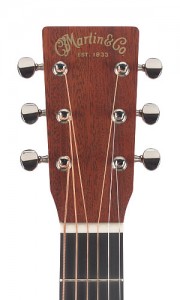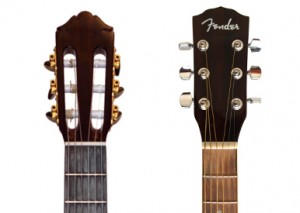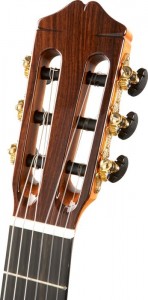Nylon or Steel?
If you’re on the market for a guitar you’re going to come across instruments sporting both nylon and steel strings and there are some differences between the two. Nylon strung guitars (classical guitars) which are commonly used in classical and flamenco music have a slotted headstock to allow the nylon strings to be wound horizontally as well as a wider fretboard and string-through bridge.

Steel string headstock
Steel string guitars (western guitars) are the most common type of acoustic guitar and are more commonly used on folk, trad, pop and country arrangements. These generally have a more narrow fretboard than their nylon-clad cousins as well as a pinned bridge and string-posts on the headstock.
Soundwise they’re both quite different. Classical guitars sound more mellow and don’t boast that steel presence or bite that western guitars are known for and yet can provide a sweet enchanting tone when used in melody applications.
If you, like most beginners are learning to play by strumming chords then a steel strung guitar is the choice for you. These are the most versatile ‘do-everything’ guitars on the market and are the go-to instrument for learning guitar. However, there are some other factors to be taken into consideration.
- Nylon strings are more forgiving on the fingers in the initial stages and this can be an important factor for younger players or those with tender skin.
- For those players with larger hands who struggle to fret congested chord shapes, the extra width of classical guitars may provide relief.
- Likewise those with smaller hands might appreciate the slightly narrower neck of a steel strung guitar.

Differing neck sizes on nylon and steel guitars
- Classical guitars are available in a wide variety of sizes. Western guitars are generally either 3/4 size or full scale sizes where as classical guitars offer in-between sizes.
- The financially cheapest guitars tend to be classical guitars so if you’re unsure whether guitar is for you, there’s no need to shell out cash on an expensive western guitar.
There’s a whole host of instruments available with different body sizes, materials, sounds and of course prices and next week’s article will cover some of these. The above has addressed the most basic of distinctions in order to help you in your choice once you’ve decided to take the first step. Happy hunting!
DM


